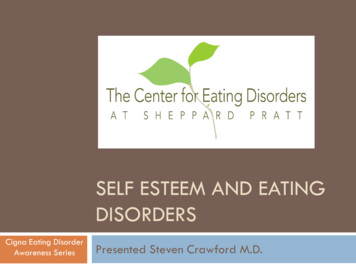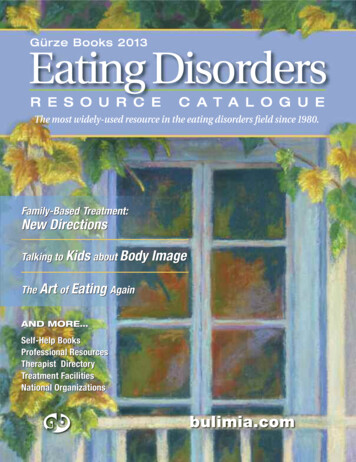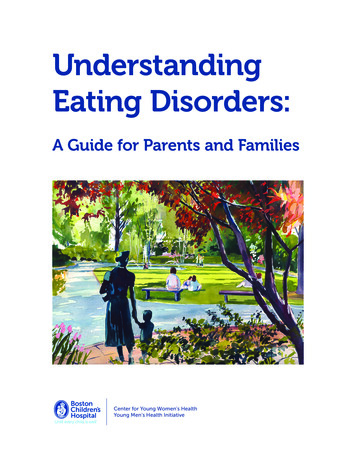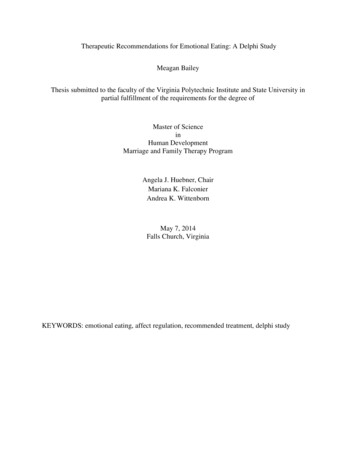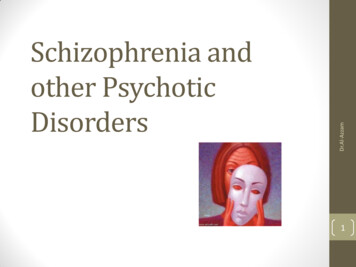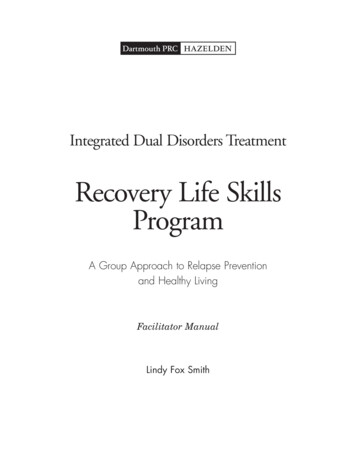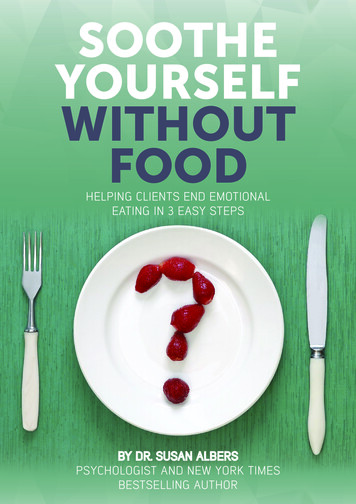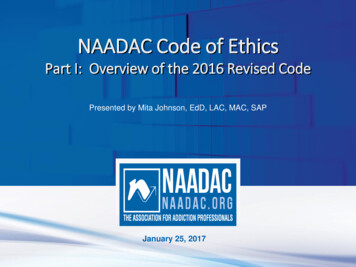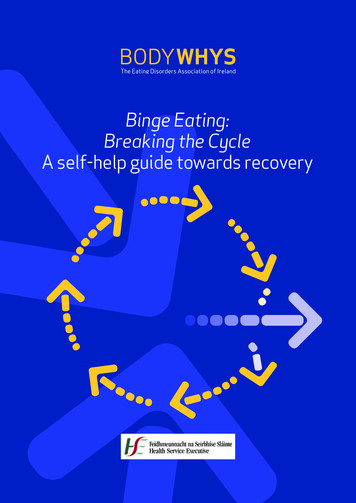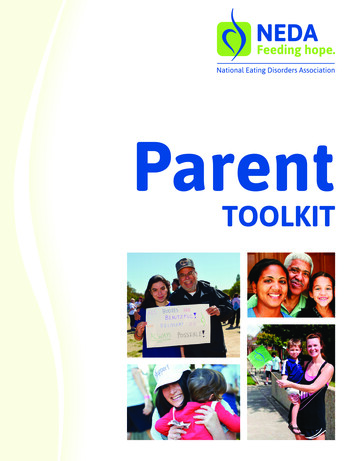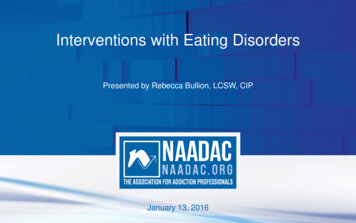
Transcription
Interventions with Eating DisordersPresented by Rebecca Bullion, LCSW, CIPJanuary 13, 2016
Interventions with Eating DisordersPresented by Rebecca Bullion, LCSW, CIPJanuary 13, 2016
Thomas Durham, PhDDirector of TrainingNAADAC, the Association for Addiction Professionalswww.naadac.orgtdurham@naadac.org
Produced ByNAADAC, the Association for Addiction Professionalswww.naadac.org/webinars
www.naadac.org/webinars
www.naadac.org/eatingdisorders
Cost to Watch:FreeCE HoursAvailable:1 CEsCE Certificate forNAADACMembers:FreeCE Certificate forNon-members: 15CE CertificateTo obtain a CE Certificate for the time you spentwatching this webinar:1.Watch this entire webinar.2.Pass the online CE quiz, which is posted atwww.naadac.org/eatingdisorders3.If applicable, submit payment for CE certificateor join NAADAC.4.A CE certificate will be emailed to you within 21days of submitting the quiz.
Using GoToWebinar – (Live Participants Only) Control Panel Asking Questions Audio (phone preferred) Polling Questions
Webinar PresenterRebecca V. Bullion, LCSW, erica.com615-414-2995Interventions with Eating Disorders
Webinar Learning Objectives12Describe clinicalfeatures of differentEating Disorder typesDescribe three modelsof intervention andapply them to EatingDisorders3Describe three tools forintervening with EatingDisorders
What is Intervention?The process whereby friends, family and concernedindividuals confront the person engaging indestructive compulsive behaviors and addictions inorder to circumvent the process and regain a positive,healthy balance and thus diminish the physical,mental, emotional and spiritual decay of addiction.
Reasons to Conduct an Eating DisorderIntervention Seeing the health and mental decline of a client, patient, friend orfamily member Understanding that the person is suffering Realizing that you (family/friend) are also suffering with theIdentified Patient (IP)
Risk Factors for Eating Disorders Being female Family history of Eating Disorders (ED) Mental Health Disorders history in family and IP Being age 15-20 Socio-cultural factors Sports involvement/athletic lifestyle Stress Dieting Life Transitions
Types of Eating Disordersand Their Symptoms
Anorexia Nervosa
Diagnostic Criteria for Anorexia Nervosa(AN)A. Refusal to maintain body weight at or above a minimally normalweight for age and height (e.g., weight loss leading to maintenance ofbody weight less than 85% of that expected; or failure to make expectedweight gain during period of growth, leading to body weight less than85% of that expected).B. Intense fear of gaining weight or becoming fat, even thoughunderweight.C. Disturbance in the way in which one’s body weight or shape isexperienced, undue influence of body weight or shape on selfevaluation, or denial of the seriousness of the current low body weight.D. In postmenarcheal females, amenorrhea, i.e., the absence of at leastthree consecutive menstrual cycles.
Four Aspects of Body Image1. Perceptual – the way you see yourself2. Affective – the way you feel about yourself3. Cognitive – the thoughts and beliefs youhave about yourself4. Behavioral – the things you do in relation tothe way you look
Other Signs of AN Wearing baggy clothes to hide weight loss Bizarre eating habits and rituals Fine hair (lanugo) on arms, neck, face, etc. Pale skin and dull, brittle/dry hair Complaints of stomach trouble and pain Cessation of menses Fidgety in addition to over exercise Eating alone and stating not hungry Orange hands from eating a lot of carrots
Body Mass IndexAN is diagnosed when BMI is 17.5 or less and is aresult of food restriction and malnutrition Normal weight: 18.5-24.9 (Normal BMI) Overweight:25-29.9 Obese:30
Bulimia NervosaSymptoms: Frequent episodes of consuming very large amountof food followed by behaviors to prevent weightgain, such as self-induced vomiting A feeling of being out of control during the bingeeating episodes Self-esteem overly related to body image(from National Eating Disorders Association)
Binge Eating Disorder (BED) Eating large amounts of food/calories in a short periodof time No efforts to over exercise or purge in order to reduceeffects of overeating but some worry about effects ofovereating Shame, guilt, self-loathing during and after a binge Eating when full, hoarding food, eating normally in frontof others, eating continuously without regular mealtimes
Other Types of EDNot official clinical terminology for newer ED phenomenonPregorexia:A term coined by the media that refers to a pregnant woman whoexercises excessively and reduces calories dramatically in orderto rigidly control pregnancy weight gain. There are no goodstatistics on this condition or these behaviors at this time.From www.sharecare.com
Woman 6 months -39703-baby-post.html
Orthorexia Obsession with eating healthy food Distress at eating unhealthy food Judging others for eating unhealthy food Adherence to rigid rules about certain food to eat ornot eat Fear of weight gain as in AN isn't prevalentsymptom
ManorexiaA term that has been used to refer to anorexianervosa in males. This is not an officially recognizedmedical term but has been frequently used in mediareports.www.medicinenet.com
1 in 4 diagnosed with anorexia is male
DrunkorexiaThe term drunkorexia has been coined to describe the conditionof binge drinking combined with the typical self-imposedstarvation seen with anorexia nervosa. It has also been used torefer to individuals who use purging (as seen with bulimianervosa) or who have other eating disorders and try to reducecaloric intake to offset the calories consumed in alcohol. Thetypical individual described as a drunkorexic is a college-agedwoman who is a binge drinker, starving all day in order to getdrunk at night.www.medicinenet.com
DiabulimiaDiabulimia is a form of eating disorder that affects people takinginsulin to treat diabetes. It refers to the practice of minimizinginsulin dosages by patients with type 1 diabetes mellitus in anattempt to control body weight. Since insulin encourages fatstorage, the manipulation of insulin dose is an attempt to reduceweight gain. The term does not refer to a recognized medicalcondition but to a practice recognized by diabetes experts.Diabulimia is most common in young girls and women with type 1diabetes.www.medicinenet.com
Polling Question #1
Tools for Brief Intervention Can be administered during intake process withmedical or psychotherapy clients in order to identifyall the issues one is facing Can be questions used in conversation to helpsomeone identify and seek help for ED
ED Screening QuestionsGeneral Screening Questions SAMHSA SubstanceAbuse Treatment -Addressing the Specific Needs ofWomen (TIP 51)1. How satisfied are you with your weight and shape?2. How often do you try to lose or gain weight?3. How often have you dieted?4. What other methods have you used to lose weight?
ED Screening (Con't.)Specific Screening Questions:1. Have you ever lost weight and weighed less than othersthought you should?2. Have you ever had eating binges in which you eat a largeamount of food in a short period of time?3. Do you ever feel out of control when eating?4.Have you ever vomited to lose weight or to get rid of food thatyou have eaten?5. What other sorts of methods have you used to lose weight orto get rid of food?
EAT-26 QuestionnaireBy Garner and Garfinkel Standardized questionnaire asking questions regardingsymptoms and concerns characteristic of eating disorders Three subscales – dieting, bulimia and foodpreoccupation/food control Testing does have room for false negative because it is byself reportwww.eat-26.com Has a downloadable permission form for obtaining andusing the form without cost
FACESFamily Adaptability and Cohesion ScaleAssesses family typesSix Family Types (Using cluster analysis of the six FACES IV scales, sixfamily types were identified):1. Balanced2. Rigidly Cohesive3. Midrange4. Flexibly Unbalanced5. Chaotically Unbalanced6. Unbalancedwww.facesiv.com
FACES (Con't.) Has a 10 item scale to address FamilyCommunication Has a 10 item scale to address Family Satisfaction Basically, it's a scale to measure different aspects offamily functionality
Medical Necessity for Residential orInpatient Admission Ensure that the criteria are met for the diagnosis With ED there must be imminent harm to body or imminent harm to co-morbidpsychiatric problems such as suicidal ideation Treatment “failure” at a lower level of treatment such as weekly outpatient orintensive outpatient (includes patient being uncooperative with treatment atlower levels of care) With anorexia certain weight and BMI measurements must be met There must be a need for supervision in order to interrupt a binge/purge cycleor to ensure weight gain Lack of family support or inability of the family support system in order toimprove symptoms. Presence of family conflict
Roadblocks to Successful InterventionAs with a substance abuse or other type of intervention there are theproblems of:1. Denial in the forms of minimization, rationalization2. Avoidance of discussing, maintenance of control and secrecyaround the problem3. Getting through to the enabling system around the IP4. Access and resources for treatment5. Battling dual diagnosis problems
FAMILY DYNAMICSWorking through family dynamics andissues is often THE BIGGEST roadblockto successful intervention
Codependency Definition (Wikipedia)A psychological condition in which aperson is manipulated by another who isaffected by a pathological condition (suchas addiction). The codependent places alower priority on his/her own needs whilebeing excessively preoccupied with theneeds of others.
Shame-Based Family System Shame creates an emotional pressure that is basically intolerablewithout a mediator. Shaming is a series of behaviors that attacks the sense of self andego formation and results in a response similar to a threat to survival. Shame affects the deep emotive areas of the brain in the amygdale. Shaming systems are static and have little capacity to adapt. If a person cannot avoid shame, he/she will attempt to adapt to it.Addiction is a form of adaptation.
Beliefs in an Addictive Family System Belief that the entire system revolves around the person whois addicted and that this person holds all the perceived power,especially the power to change the family system. i.e. “things would be wonderful if., we would all be happyif.the addict would stop using and causing problems.”
Codependency Definition (Cont’d) Denial – trying to normalize the addictive behavior. This denialsupports the addict's denial and helps the illness progress. The addictgains confidence that everything is o.k. Control – Hoping to influence the situation. Anger/Depression- when attempts to control fail, the codependentbegins to get angry or depressed over the perceived failure to changethe addict. Rejection – of the addict vs. detaching in love. This rejection of addictoften does not last and cycle repeats.
Families of Anorectics High degree of fusion, enmeshment orblurred/unclear boundaries, poor individuationamong family member Restriction at attempts toward autonomy andseparation with family cohesion being greatly valued Rigid outer boundaries toward outside influences.Closed family system
Anorectic FamiliesMinuchin first noted these symptoms of: Conflict Avoidance Overprotectiveness Rigidity Enmeshment
Anorectic Families Power in these families is gained by the memberwho gives the most, sacrifices the most, suppresseshis/her own needs and desires the most. Taking toomuch for self is seen as “letting self go” or beingselfish. The scene is set for a martyrdom contest and acompetition of self-sacrifice.
Families of Bulimics Tend to be much more chaotic More disengaged vs. enmeshed althoughenmeshment around hostility is present Little affection and emotional support to IP More parent/child conflict
Families of Bulimics (Cont’d) Families may overwhelm child with food Families may convey that whatever child does, it isnever good enough Mothers of bulimics often have their own weightproblems and an excessive focus on dieting and/orbody image
Attachment Disorder/EDPerhaps ED is more about attachmentthan food. A client's relationship withfood is a lot like their relationships withpeople. In times of stress, it substitutesfor comfort from people. Food is atransitional object that can be controlledand is always accessible.Mark Schwartz, Castlewood Treatment Centers
Polling Question #2
Dual Diagnosis Substance Use/Eating DisorderNational Eating Disorders Association (NEDA) websitestates that 50% of individuals with eating disordersalso have substance use problems. This statistic canbe interpreted also to mean that individuals with eatingdisorders are 5x more likely to have a substance useproblem than the non-ED person.
Intervention Models
Johnson ModelDeveloped by Vernon Johnson Considered to be very confrontational Also called the “surprise model” It's the model most people think of when they think of intervention
Systemic ModelDeveloped by Wayne Raiter Family viewed as Identified Patient (IP) Attempts to change the the focus away from shame and behavior ofthe addict to individual change in each member, and consequently, inthe system This model often results in more than one individual in the systemgoing to treatment This model encourages family members to keep the focus on thingsthey can control Underlying philosophy of gentleness and respect are critical to thismodel
ARISE ModelDeveloped by Judith Landau and Jim Garrett It is a pre-treatment model that focuses on thepositive outcomes of treatment vs. the negativebehaviors of addict Often called Invitational model
Selection Process Members included would be family, friends, co-workers andpeople who have first hand knowledge of the addiction inaction Group should not be larger than 5-6 people Do not include children although letters from children may beread in intervention
Deselection Process Deselect anyone who cannot contain their anger Anyone whose relationship with IP is mostly very toxic leadingto a fight/argument during the Intervention Anyone whose addiction and using would interfere with focuson IP's addiction
Impact Letters1. Three positive memories you have with the IP and/or threethings that you love about the person2. Three concerns you have based on the symptoms of declinethat you have observed or know are occurring3. Three wishes you have for the future of your relationship withthe IP and for the IP's health and future
Consequence LettersPart Two would include: Two to three boundaries that the Intervention Team personwrites about what he/she is no longer going to do to enable theaddiction With Eating Disorder Intervention the use of boundaries/leverage is minimized and invitation for help is primary focus
Moving Toward a Model forEatingDisorder Intervention
Uncharted Waters
Intervention Team Screening Health Practitioner (Doctor or Nurse Practitioner) Therapist to treat at lower levels of care and address familyissues and diagnosis Interventionist to manage the moving parts Team lead point person for friends and family portion ofintervention A nutritionist to help establish food plan and intervene aroundthe success or failure of adhering to a food plan
A Successful Model Would Include: Addressing the family system issues that enable and shame the IP Addressing the needs of the system as a whole i.e. IP may not bethe only one that gets some level of treatment Teaching and coaching on how family members communicate witheach other around addiction issues and communication overall
CRAFT Model - CommunityReinforcement and Family TrainingDr. Robert Meyers, a research associate andprofessor in psychology, developed this innovativeapproach after growing up with an alcoholic father. Hediscusses how a family member can change theirdynamic with the addict and help them take the firststeps toward seeking treatment
Five Things to Know about CRAFT1. CRAFT is a motivational model of help based on research that consistently findsmotivational treatments to be superior to confrontational ones.2. More than two-thirds of family members who use CRAFT successfully engagetheir substance using loved ones in treatment.3. Evidence suggests that substance users who are pushed into treatment by atraditional confrontational intervention are more likely to relapse than clients whoare encouraged into treatment with less confrontational means.4. Family members who use CRAFT experience greater improvements in theiremotional and physical health than do those who use confrontational methods totry to help their loved ones.5. People who use CRAFT are more likely to see the process through to successthan those who use confrontational methods.www.hbo.com/addiction/treatment
CRAFT (Con't.)Specifically, CRAFT teaches several skills, including: Understanding a loved one’s triggers to use substances Positive communication strategies Positive reinforcement strategies – rewarding non-usingbehavior Problem-solving Self-care Domestic violence precautions Getting a loved one to accept help
Other Significant Component ofED Model InterventionNo shameNo secret keepingFocus on an Al-Anon approach of self-careFamily Therapy for minors and often for adult IPs as well
Community Eating Positive interactions around food andaround mealtime Maudsley Approach
Resources National Eating Disorders Association:Screening tools, support groups, parenting around ED toolkit, research studieswww.nationaleatingdisorders.org Alliance for Eating Disorders:Outreach, education and early intervention resourceswww.allianceforeatingdisorders.com Finding Balance:Support groups, daily meditations, annual conference, tx providerswww.findingbalance.com www.maudsleyparents.org
THANK YOU!Rebecca V. Bullion, LCSW, erica.com615-414-2995Interventions with Eating Disorders
www.naadac.org/eatingdisorders
Cost to Watch:FreeCE HoursAvailable:1 CEsCE Certificate forNAADACMembers:FreeCE Certificate forNon-members: 15CE CertificateTo obtain a CE Certificate for the time you spentwatching this webinar:1.Watch this entire webinar.2.Pass the online CE quiz, which is posted atwww.naadac.org/eatingdisorders3.If applicable, submit payment for CE certificateor join NAADAC.4.A CE certificate will be emailed to you within 21days of submitting the quiz.
Upcoming WebinarsJanuary 27, 2016February 24, 2016Treating Substance Use Disorders in BrainInjury Survivorsby Christine BrentonThe Spirituality of Addictionby Nina Marie CaronaFebruary 10, 2016March 9, 2016The Neurocognitive Effects of MaternalPrenatal Alcohol Consumption on the Fetusand Postnatal Developing Childby Paulette PrittBuild Your Business with the DOT/SAPQualificationby Wanda McMichaelwww.naadac.org/webinars
www.naadac.org/webinarsFree CEs aadac.org/join
WEBINAR SERIESOver 75 CEs of free educationalwebinars are available. Educationcredits are FREE for NAADACmembers.MAGAZINE ARTICLESIn each issue of Advances inAddiction & Recovery, NAADAC'smagazine, one article is eligible forCEs.FACE-TO-FACE SEMINARSNAADAC offers face-to-faceseminars of varying lengths in theU.S. and abroad.INDEPENDENT STUDYCOURSESEarn CEs at home and at your ownpace (includes study guide andonline examination).CONFERENCESNAADAC Annual Conference inMinneapolis, MinnesotaOctober 7-11, 2016.CERTIFICATE PROGRAMSDemonstrate advanced educationin diverse topics with the NAADACCertificate Programs.
Contact Us!NAADACorgNAADAC1001 N. Fairfax Street, Suite 201Alexandria, VA 22314phone: 703.741.7686 / 800.548.0497fax: 703.741.7698 / AADAC
Codependency Definition (Cont'd) High degree of fusion, enmeshment or blurred/unclear boundaries, poor individuation among family member Restriction at attempts toward autonomy and separation with family cohesion being greatly valued Rigid outer boundaries toward outside influences.
